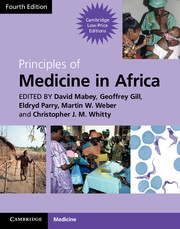Book contents
- Frontmatter
- Contents
- Contributors
- Foreword
- Section 1 Health and disease
- Section 2 Mother and child health
- Section 3 Infection: general principles
- Section 4 Major common infections
- Section 5 Bacterial infections
- Section 6 Viral Infections
- Section 7 Protozoal infections
- Section 8 Helminth infections
- Section 9 Fungal infections
- Section 10 Non-communicable diseases
- Section 11 Diseases of body systems
- 65 The heart
- 66 The lung
- 67 Blood disorders
- 68 The gut
- 69 The liver
- 70 The kidney and body fluids
- 71 Bones and joints
- 72 Endocrinology
- 73 The nervous system
- 74 The skin
- 75 The eye
- Section 12 Cancer and Palliative Care
- Section 13 Venoms and Poisons
- Index
- References
68 - The gut
from Section 11 - Diseases of body systems
Published online by Cambridge University Press: 05 March 2013
- Frontmatter
- Contents
- Contributors
- Foreword
- Section 1 Health and disease
- Section 2 Mother and child health
- Section 3 Infection: general principles
- Section 4 Major common infections
- Section 5 Bacterial infections
- Section 6 Viral Infections
- Section 7 Protozoal infections
- Section 8 Helminth infections
- Section 9 Fungal infections
- Section 10 Non-communicable diseases
- Section 11 Diseases of body systems
- 65 The heart
- 66 The lung
- 67 Blood disorders
- 68 The gut
- 69 The liver
- 70 The kidney and body fluids
- 71 Bones and joints
- 72 Endocrinology
- 73 The nervous system
- 74 The skin
- 75 The eye
- Section 12 Cancer and Palliative Care
- Section 13 Venoms and Poisons
- Index
- References
Summary
The problem in Africa
Gastrointestinal disease accounts for a major proportion of the work load of health care workers throughout the world, and this is especially true in Africa. Unfortunately, there is little published information on the prevalence of many important diseases, which makes it difficult to generalize about the profile of disease around the continent. Much of this chapter reflects our personal experience in Zambia, and we analyse the literature where it is helpful. The epidemiology of those diseases that require diagnosis by endoscopy or radiology (for example, inflammatory bowel disease and cancer) is especially poorly described.
We begin with the epidemiology of selected important disorders of the digestive tract, then describe the spectrum of disease by anatomical location and symptom. We will try to point out what is firmly established and what is less clear. There are specific chapters on several gastrointestinal infectious diseases elsewhere in the book, which complement, and so need to be read together with, this chapter. These include diarrhoea, cholera, salmonellosis, amoebiasis and other intestinal protozoa (Chapters 9, 22, 33, 44 and 45).
Epidemiology of selected diseases
Peptic ulceration and Helicobacter pylori
The cause of peptic ulceration remained unexplained for many years, and even now there are many unanswered questions. In the early 1980s it was discovered that the great majority of peptic ulceration is related to infection with a recently discovered bacterium, which colonizes the gastric mucosa of a large proportion of the world’s population: Helicobacter pylori. However, it is not understood why H. pylori infection only causes gastroduodenal disease at certain points in time in a small proportion of those individuals infected.
- Type
- Chapter
- Information
- Principles of Medicine in Africa , pp. 656 - 670Publisher: Cambridge University PressPrint publication year: 2013



